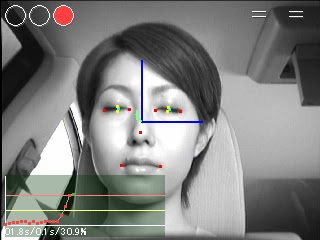 Nissan presented a new concept car equipped with various systems that not only detect and warn drivers about their state of sobriety, but they also take matters into their hands immobilizing the vehicle. The systems incorporated in Nissan’s concept car include a facial monitor that detects driver’s consciousness through eyes, a driving monitor that checks the behavior of the vehicle –eg. If the car strays out of its driving lane, and alcohol odor sensors integrated into the driver’s and passenger seats to detect the presence of alcohol in the air inside the vehicle cabin. These systems issue visual and voice warning alerts and/or tighten the driver’s seat belt.
Nissan presented a new concept car equipped with various systems that not only detect and warn drivers about their state of sobriety, but they also take matters into their hands immobilizing the vehicle. The systems incorporated in Nissan’s concept car include a facial monitor that detects driver’s consciousness through eyes, a driving monitor that checks the behavior of the vehicle –eg. If the car strays out of its driving lane, and alcohol odor sensors integrated into the driver’s and passenger seats to detect the presence of alcohol in the air inside the vehicle cabin. These systems issue visual and voice warning alerts and/or tighten the driver’s seat belt.
Most importantly though, Nissan’s experimental vehicle also features a sensor built into the transmission shift knob. The latter can spot the presence of alcohol in the perspiration of the driver’s palm. If the alcohol-level detected is above the pre-determined threshold, then the system automatically locks the transmission, immobilizing the car. While we totally agree with the “Drink? Then Don’t Drive” concept, to be honest we’re not so sure about our car having a mind of its own. -Press release after the jump
CONCEPT CAR TO SHOWCASE ANTI DRINK-DRIVING TECHNOLOGY
TOKYO (3 August, 2007) – Nissan Motor Co., Ltd has revealed a new concept car featuring multiple preventative features designed to reduce drink-driving. The various technologies are designed to detect the driver’s state of sobriety and to activate a range of preventive measures including immobilization of the vehicle.
This concept car was developed as an exploratory platform to showcase breakthrough technologies that could potentially be applied to future production cars, part of an ongoing programme from Nissan contributing towards the prevention of drink-driving.
Nissan has already launched and is developing several initiatives to help prevent drunk-driving. In June, the company introduced the “drink-driving” message alert on its navigation system. In July, Nissan also began testing of a new on-board breathalyser system in cooperation with several local government authorities, where an interlock mechanism will immobilise the vehicle if the driver’s breath indicates the presence of alcohol above a specified level.
Nissan is taking a holistic approach towards safety that extends beyond the technology built into its vehicles. To achieve a “safe driving environment”, Nissan has embarked on the Intelligent Transport System Project (ITS) in Kanagawa Prefecture – aimed at helping to reduce road accidents via the analysis of traffic data collected from on-the-road vehicles and traffic beacons. In Japan, the company’s safety vision is to halve the number of traffic fatalities or serious injuries involving Nissan vehicles by 2015 compared with the level in 1995.
1) A hi-sensitivity alcohol odour sensor is built into the transmission shift knob which is able to detect the presence of alcohol in the perspiration of the driver’s palm as he or she attempts to start driving. When the alcohol-level detected is above the pre-determined threshold, the system automatically locks the transmission, immobilising the car. A “drink-driving” voice alert is also issued via the car navigation system.
2) Additional alcohol odour sensors are also incorporated into the driver’s and passenger seats to detect the presence of alcohol in the air inside the vehicle cabin. When alcohol is detected, the system issues both a voice alert and a message alert on the navigation system monitor.
A camera is mounted on the instrument cluster facing the driver to monitor the driver’s face. The system is calibrated to monitor the driver’s state of consciousness through eyes. When the system detects signs of drowsiness, a voice and message alert is triggered via the navigation system. Additionally, a seat-belt mechanism is activated which tightens around the driver to gain his or her immediate attention.
By constantly monitoring the operational behaviour of the vehicle (e.g. sensing if the vehicle is drifting out of its driving lane), the system can identify signs of inattentiveness or distraction in the driver. When the system detects such behaviour, voice and message alerts are issued via the navigation system. The seat-belt alert mechanism is also activated, tightening around the driver to gain immediate attention.












